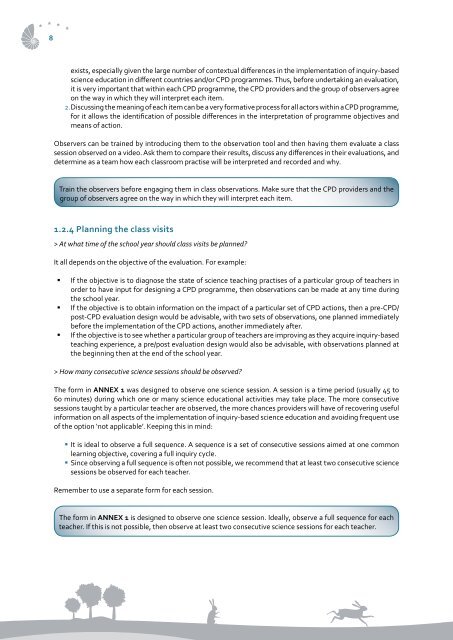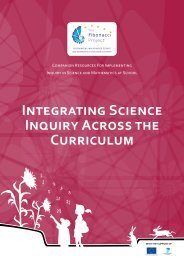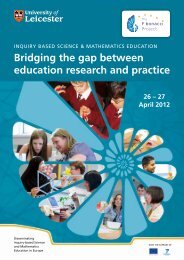Tools for Enhancing Inquiry in Science Education - Fibonacci-Project
Tools for Enhancing Inquiry in Science Education - Fibonacci-Project
Tools for Enhancing Inquiry in Science Education - Fibonacci-Project
You also want an ePaper? Increase the reach of your titles
YUMPU automatically turns print PDFs into web optimized ePapers that Google loves.
89exists, especially given the large number of contextual differences <strong>in</strong> the implementation of <strong>in</strong>quiry-basedscience education <strong>in</strong> different countries and/or CPD programmes. Thus, be<strong>for</strong>e undertak<strong>in</strong>g an evaluation,it is very important that with<strong>in</strong> each CPD programme, the CPD providers and the group of observers agreeon the way <strong>in</strong> which they will <strong>in</strong>terpret each item.2. Discuss<strong>in</strong>g the mean<strong>in</strong>g of each item can be a very <strong>for</strong>mative process <strong>for</strong> all actors with<strong>in</strong> a CPD programme,<strong>for</strong> it allows the identification of possible differences <strong>in</strong> the <strong>in</strong>terpretation of programme objectives andmeans of action.Observers can be tra<strong>in</strong>ed by <strong>in</strong>troduc<strong>in</strong>g them to the observation tool and then hav<strong>in</strong>g them evaluate a classsession observed on a video. Ask them to compare their results, discuss any differences <strong>in</strong> their evaluations, anddeterm<strong>in</strong>e as a team how each classroom practise will be <strong>in</strong>terpreted and recorded and why.1.2.5 Gather<strong>in</strong>g the data> Prepar<strong>in</strong>g the visitBe<strong>for</strong>e visit<strong>in</strong>g a class, it is important to expla<strong>in</strong> the purpose of the visit to the teacher: rem<strong>in</strong>d them that thistool is not meant to ‘score’ them on their teach<strong>in</strong>g (no summative evaluation will result from these observations)and will have no repercussions whatsoever <strong>in</strong> terms of their teach<strong>in</strong>g career. The tool is meant to give <strong>for</strong>mativefeedback to CPD providers.It is also important to plan at least 15 m<strong>in</strong>utes <strong>for</strong> an <strong>in</strong>terview with the teacher, either be<strong>for</strong>e or after the sciencelesson, and another 15 m<strong>in</strong>utes to look over students’ written records.Tra<strong>in</strong> the observers be<strong>for</strong>e engag<strong>in</strong>g them <strong>in</strong> class observations. Make sure that the CPD providers and thegroup of observers agree on the way <strong>in</strong> which they will <strong>in</strong>terpret each item.1.2.4 Plann<strong>in</strong>g the class visits> At what time of the school year should class visits be planned?It all depends on the objective of the evaluation. For example:• If the objective is to diagnose the state of science teach<strong>in</strong>g practises of a particular group of teachers <strong>in</strong>order to have <strong>in</strong>put <strong>for</strong> design<strong>in</strong>g a CPD programme, then observations can be made at any time dur<strong>in</strong>gthe school year.• If the objective is to obta<strong>in</strong> <strong>in</strong><strong>for</strong>mation on the impact of a particular set of CPD actions, then a pre-CPD/post-CPD evaluation design would be advisable, with two sets of observations, one planned immediatelybe<strong>for</strong>e the implementation of the CPD actions, another immediately after.• If the objective is to see whether a particular group of teachers are improv<strong>in</strong>g as they acquire <strong>in</strong>quiry-basedteach<strong>in</strong>g experience, a pre/post evaluation design would also be advisable, with observations planned atthe beg<strong>in</strong>n<strong>in</strong>g then at the end of the school year.> How many consecutive science sessions should be observed?The <strong>for</strong>m <strong>in</strong> ANNEX 1 was designed to observe one science session. A session is a time period (usually 45 to60 m<strong>in</strong>utes) dur<strong>in</strong>g which one or many science educational activities may take place. The more consecutivesessions taught by a particular teacher are observed, the more chances providers will have of recover<strong>in</strong>g useful<strong>in</strong><strong>for</strong>mation on all aspects of the implementation of <strong>in</strong>quiry-based science education and avoid<strong>in</strong>g frequent useof the option ‘not applicable’. Keep<strong>in</strong>g this <strong>in</strong> m<strong>in</strong>d:• It is ideal to observe a full sequence. A sequence is a set of consecutive sessions aimed at one commonlearn<strong>in</strong>g objective, cover<strong>in</strong>g a full <strong>in</strong>quiry cycle.• S<strong>in</strong>ce observ<strong>in</strong>g a full sequence is often not possible, we recommend that at least two consecutive sciencesessions be observed <strong>for</strong> each teacher.Remember to use a separate <strong>for</strong>m <strong>for</strong> each session.The <strong>for</strong>m <strong>in</strong> ANNEX 1 is designed to observe one science session. Ideally, observe a full sequence <strong>for</strong> eachteacher. If this is not possible, then observe at least two consecutive science sessions <strong>for</strong> each teacher.Make sure the teacher understands the objective of your visit: give <strong>for</strong>mative feedback to CPD providers, notevaluate their teach<strong>in</strong>g. Plan a 15-m<strong>in</strong>ute <strong>in</strong>terview with the teacher and some time to look over students’written records.> Dur<strong>in</strong>g the visit• Be<strong>for</strong>e or after the science lesson: items <strong>in</strong> the section ‘Interview with the teacher’ of the <strong>for</strong>m <strong>in</strong> ANNEX 1are to be completed through an <strong>in</strong>terview with the teacher. Items <strong>in</strong> section C (‘Pupils’ written records’) areto be completed by analys<strong>in</strong>g several pupils’ written records (ideally, at least one record from each groupof pupils), which can be done either be<strong>for</strong>e, after, or dur<strong>in</strong>g the lesson.• Dur<strong>in</strong>g the science lesson: <strong>in</strong> order to fill <strong>in</strong> sections A and B of the <strong>for</strong>m, we recommend that observerstake notes on a separate sheet of paper, to rem<strong>in</strong>d them of specific events, and then record their evaluationand their comments on the <strong>for</strong>m only after the lesson is f<strong>in</strong>ished. Observers may choose to organisetheir notes <strong>in</strong> two separate sections correspond<strong>in</strong>g to those of the <strong>for</strong>ms: ‘Teacher-pupil <strong>in</strong>teractions’ and‘Pupils’ activities’ (<strong>in</strong>teractions among pupils or activities <strong>in</strong> which the teacher is not <strong>in</strong>volved).Make sure you know how and when to recover the <strong>in</strong><strong>for</strong>mation to fill <strong>in</strong> each section of the <strong>for</strong>m <strong>in</strong> ANNEX 1.Fill <strong>in</strong> the <strong>for</strong>m only after the lesson is over. Dur<strong>in</strong>g the lesson, take notes on a separate sheet of paper.> After the visitIt is important to record on the <strong>for</strong>m <strong>in</strong> ANNEX 1 quickly after the class is over, so that the details will not be<strong>for</strong>gotten. For items <strong>in</strong> Sections A, B, and C of the <strong>for</strong>m, evaluation is recorded as ‘yes’, ‘no’ or ‘not applicable’ (NA):• YES implies that the practise occurred and that it was relevant <strong>in</strong> the context of the observation.• NO implies that the practise did not occur at all or occurred only rarely, but that it was relevant <strong>in</strong> thecontext of the observation.• NA implies that the practise is not relevant <strong>in</strong> the context of the session observed. There may be manycontextual reasons <strong>for</strong> record<strong>in</strong>g NA. For example:• The item is not relevant <strong>for</strong> the particular session be<strong>in</strong>g observed. For <strong>in</strong>stance, items 4e – 4i, whichconcern the execution of an experimental design, are not relevant <strong>for</strong> a session <strong>in</strong> which pupils designedan experimental plan and stated hypotheses but did not actually carry out the experiment.• The item is not relevant <strong>for</strong> the type of <strong>in</strong>quiry activity be<strong>in</strong>g observed. For <strong>in</strong>stance, items 2e and4d, which concern fair test<strong>in</strong>g, may not be relevant <strong>in</strong> an <strong>in</strong>quiry activity where only observation is<strong>in</strong>volved.




